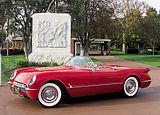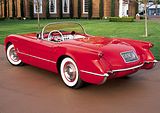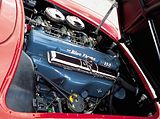|
The 1954 Corvette featured only detail changes from the previous year. These slight but significant changes included a new camshaft, new rocker-arm cover, and improvements to the convertible top mechanism.
1954 saw few changes outside of color options, performance was poor on this model, and it was a sad year for sales, with many sitting on the lots begging for buyers. This was the last year for 6 cylinder engines in the Corvette.
For the 1954 Corvette, the workaday Blue Flame six was fitted with triple
carburetors to become the Corvette Special Six. The extra carbs plus some
internal changes boosted horsepower from 115 to 150.
1954 Corvette Manufacturing and Marketing
Corvette pricing had been a sore point with critics and would-be customers. In a ploy to make the car appear to be more competitive in this respect, Chevy lowered the advertised base figure from $3,498 to $2,774 for 1954. Or did it? In so doing, the company made the Powerglide automatic -- still the only gearbox available -- a $178.35 "mandatory option." When all the legitimate options were added -- directional signals, heater, radio, whitewalls, parking brake alarm, courtesy lights, and windshield washer -- the sticker was still about the same: precisely $3,254.10. Needless to say, most potential buyers saw through this marketing sleight of hand, and the pricing chicanery did nothing to spark sales.
The early Corvette may have had its faults, but unreliability wasn't one of them. It wasn't a temperamental prima donna that was prone to breaking down like a Jaguar, nor did it demand constant attention like a Ferrari. Not that the Corvette didn't display a few quirks: Synchronizing the triple carburetors for smooth idle and throttle response was tricky at best; and water leaks were a problem, mostly from around the top and side curtains, though the leading edges of the door openings were suspect on some units. But these problems were hardly major, and Chevy issued service bulletins to cover them. Running gear? The powertrain was as boringly reliable as in Chevy's everyday passenger models, which was expected but pleasant nonetheless -- especially in a sports car.
For all that, the Corvette arrived at a crucial crossroads by the end of 1954. Though Chevrolet had hoped that '54 volume would be as many as 1,000 units a month, the actual number built for the model year was only 3,640 -- less than a third the projected total -- and at year's end the division found itself with a surplus of some 1,500 cars.
Would-be buyers were put off by Chevrolet's ill-conceived "teaser" marketing approach, which amounted to "look, but don't touch." Additionally, the Corvette was not considered to be a "pure" sports car but a cross between a boulevard tourer (like the Kaiser-Darrin and the soon-to-be-introduced Ford Thunderbird) and an out-and-out sports-racing roadster (like the Triumph TR2 and Jaguar XK-120). Purists sneered at what they considered to be out-of-place features, like the Powerglide transmission and nonfunctional cosmetic items like the car's dummy knock-off wheel covers, while comfort-lovers objected to inconveniences like the clapped-on side curtains, manual folding top, and a recirculating heater that didn't allow for windows-up ventilation. That there were fit-and-finish problems on top of all this didn't help matters.
But perhaps the real problem facing the Corvette was a sports-car market that remained tiny at best. Multi-car ownership was still far from common, and most motorists still needed a more practical vehicle as their primary mode of transportation. Though adequate to support low-volume imports like Jaguar or even Triumph, the market was still ridiculously small by Detroit standards, which demands sales in the tens, if not hundreds, of thousands every year. That the car was high priced further limited potential sales.
Here are the specifications for the 1954 Corvette:
Vehicle Specifications
|
Convertible
|
| Wheelbase, inches |
102.0
|
Length, inches
|
167.0 |
Width, inches
|
72.2
|
Track, inches
|
front: 57.0 rear: 59.0
|
Height, inches
|
51.3
|
Curb Weight, pounds
|
2,890 |
Mechanical Specifications (2-door convertible)
Suspension
front:Independent; upper and lower A-arms, coil springs, antiroll bar, tubular hydraulic shock absorbers
rear: Live axle on semi-elliptic leaf springs, tubular hydraulic shock absorbers
Wheels/Tires
6.70x15
Brakes
front: 11-inch drum
rear: 11-inch drum
Transmission
2-speed Powerglide
Standard axle ratio
3.55:1
Engine Specifications
| Type |
ohv I-6 |
| Displacement, liters/cu inch |
3.85/235.5 |
| Bore x stroke, inches |
3.56 x 3.95 |
| Fuel Management |
3 Carter sidedraft
|
| Horsepower @ rpm |
150 @ 4200 |
| Torque @ rpm, pound-foot |
223 @ 2400 |
Vehicle Production and Base Prices
Car Type
|
Production
|
Price
|
2-door convertible
|
3,640
|
$2,774.00 |
Options and Production
Option
|
Production
|
Price
|
Directional Signal
|
3,640
|
$16.75
|
Heater
|
3,640 |
91.40
|
| AM Radio, signal seeking |
3,640
|
145.15
|
| Whitewall Tires, 6.70 x 15 |
3,640 |
26.90 |
| Powerglide Automatic Transmission |
3,640 |
178.35
|
Parking Brake Alarm
|
3,640 |
5.65
|
| Courtesy Lights |
3,640 |
4.50
|
Windshield Washer
|
3,640 |
11.85
|
Color Choices and Production
Color Choice
|
Production |
Color Choice
|
Production |
Polo White
|
3,230
|
Pennant Blue
|
300 |
Sportsman Red
|
100
|
Black
|
4 |
|




|